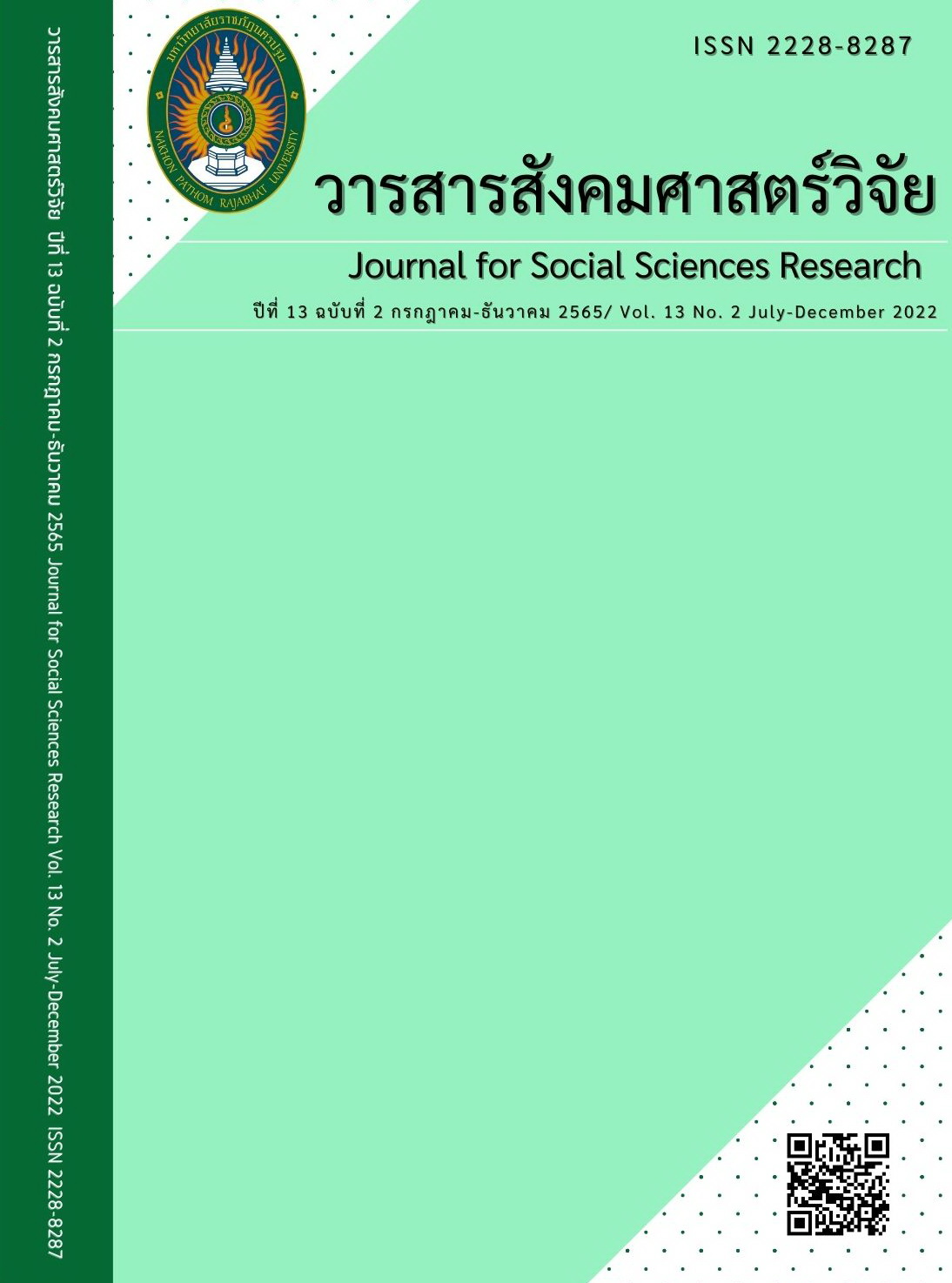KNOWLEDGE, ATTITUDE AND CONSUMPTION OF WILD EDIBLE PLANTS IN SALUANG–KEELEK COMMUNITY, MAE RIM DISTRICT, CHIANG MAI PROVINCE
Main Article Content
Abstract
The mixed methods research aimed to: 1) investigate knowledge, attitude, and consumption of wild edible plants; and 2) predict factors affecting people’s consumption of wild edible plants. The sample of this research was 303 households and 16 stakeholders in the area of Saluang-Keelek community, Mae Rim District, Chiangmai Province. Data were collected by questionnaires, non - structured interviews, and a focus group. Data were analyzed by descriptive statistics, regression analysis, and content analysis. The results showed that the knowledge of the people was at a good level (80.3 %), and the attitude was at a moderate level (Mean = 3.47 ± 0.34). The wild edible plant consumption was at a low level (Mean = 2.23 ± 0.63). Moreover, it was found that the significantly influenced factors of the wild edible plant consumption were participation in community activities (Beta = .275, p = .000) and attitudes toward the wild food plants (Beta = .375, p =.000). In conclusion, people in the area suggested factors supporting wild edible plant consumption by developing activities for the conservation of cultural ecology according to community rule and criteria, and complying relevant local wisdom knowledge.
Article Details

This work is licensed under a Creative Commons Attribution-NonCommercial-NoDerivatives 4.0 International License.
บทความที่ได้รับการตีพิมพ์เป็นลิขสิทธิ์ของมหาวิทยาลัยราชภัฏนครปฐม
เนื้อหาของแต่ละบทความเป็นทัศนะของผู้เขียน ซึ่งที่ปรึกษา บรรณาธิการ กองบรรณาธิการ และคณะกรรมการบริหารวารสารไม่จำเป็นต้องเห็นด้วย หรือร่วมรับผิดชอบใดๆ
References
จักรพงษ์ พวงงามชื่น, สวิชญา ศุภอุดมฤกษ์ ตรีรัตน์ และนคเรศ รังควัต. (2556). การพัฒนารูปแบบการมีส่วนร่วมของประชาชนในการจัดการป่าชุมชน: กรณีศึกษาบ้านทาป่าเปา ตำบลทาปลาดุก อำเภอแม่ทา จังหวัดลำพูน. วารสารวิจัยและพัฒนา มจธ., 36 (2), 245-260.
ชุติมา สามารถ และเก็ตถวา บุญปราการ. (2559). การจัดการดูแลป่าชุมชนอย่างมีส่วนร่วมของชุมชนบ้านนิคมพัฒนาที่ 1 ตำบลท่าชะมวง อำเภอรัตภูมิ จังหวัดสงขลา. วารสารมนุษยศาสตร์และสังคมศาสตร์ มหาวิทยาลัยทักษิณ, 11 (1), 193-235.
ทวีศักดิ์ เทพพิทักษ์. (2556). การใช้แบบจำลอง KAP กับการศึกษาพฤติกรรมและทัศนคติการป้องกันการติดเชื้อ เอช ไอ วี / เอดส์ ของคนประจำเรือไทย. วารสารวิทยาการจัดการ, 8 (2), 84-102.
พลอยระดา ภูมี และปิยะนุช โทมล. (2560). ความหลากหลายและการใช้ประโยชน์ของพืชอาหารป่าในตลาดพื้นบ้านอีสานกรณีศึกษา พื้นที่ลุ่มน้ำห้วยหลวง ภาคตะวันออกเฉียงเหนือ ประเทศไทย. วารสารพื้นถิ่น โขง ชี มูล, 3 (1), 187-212.
สถาบันชุมชนลุ่มน้ำโขง. (2561). พืชอาหารจากป่าแม่ปืม. เชียงใหม่: วนิดาการพิมพ์.
สามารถ ใจเตี้ย และคณะ. (2564). การใช้ประโยชน์ และข้อเสนอเชิงนโยบายเพื่อการอนุรักษ์สมุนไพรพื้นบ้าน: กรณีศึกษาชุมชนสะลวง-ขี้เหล็ก อำเภอแม่ริม จังหวัดเชียงใหม่. วิจัยราชภัฏเชียงใหม่, 22 (2), 90-102.
สามารถ ใจเตี้ย และคณะ. (2565). การใช้ประโยชน์ และการมีส่วนร่วมของประชาชนเพื่อการอนุรักษ์พืชอาหารจากป่า ชุมชนสะลวง-ขี้เหล็ก อําเภอแม่ริม จังหวัดเชียงใหม่. วารสารการพัฒนาชุมชนและคุณภาพชีวิต, 10 (2), 180-189.
สุรพงษ์ โสธนะเสถียร. (2533). การสื่อสารกับสังคม. กรุงเทพฯ: โรงพิมพ์จุฬาลงกรณ์มหาวิทยาลัย.
สุรศักดิ์ นุ่มมีศรี. (2559). พฤกษศาสตร์พื้นบ้านและนิเวศวัฒนธรรมเพื่อการสร้างจิตสำนึกในการอนุรักษ์พืชอาหารจากป่า กรณีศึกษาชุมชนสะลวง-ขี้เหล็ก อำเภอเเม่ริม จังหวัดเชียงใหม่. เชียงใหม่: มหาวิทยาลัยราชภัฏเชียงใหม่.
Abdolbaset, G., Gerhard, L. & Joachim, S. (2012). A comparison of the wild food plant use knowledge of ethnic minorities in Naban River Watershed National Nature Reserve, Yunnan, SW China. Journal of Ethnobiology and Ethnomedicine, 8 (17), 2-9.
Abidullah S. et al. (2021). Consumption of wild food plants among tribal communities of Pak-Afghan border, near Bajaur, Pakistan. Acta Ecologica Sinica, Retrieved 8 May 2022, from https://doi.org/10.1016/j.chnaes.2021.08.002
Avik, R., Rajasri, R. & Sreevidya, E.A. (2020). How many wild edible plants do we eat—their diversity, use, and implications for sustainable food system: an exploratory analysis in India. Frontiers in Sustainable Food Systems, 4, 56. Retrieved 8 May 2022, from https://doi.org/10.3389/fsufs.2020.00056
Daniel, W. W. (2010). Biostatistics: Basic concepts and methodology for the health sciences (9th ed.). New York: John Wiley & Sons.
Elizabeta, M. M., Angelina, S. & Suzana, J. (2020). Traditional uses of wild edible plants in the Republic of North Macedonia. Phytologia Balcanica, 26 (1), 155-162.
Kargıoğlu, M. et al. (2008). An ethnobotanical survey of inner-West Anatolia, Turkey. Journal of Human Ecology, 36, 763-777.
Motti, R. (2022). Wild edible plants: a challenge for future diet and health. Plants (Basel), 11 (3), 344. Retrieved 26 July 2022, from https://doi:10.3390/plants11030344
Shumsky, S. A. et al. (2014). Understanding the contribution of wild edible plants to rural social-ecological resilience in semi-arid Kenya. Ecology and Society, 194, 34. Retrieved 2 May 2022, from http://dx.doi.org/10.5751/ES-06924-190434
Thakur, D., Sharma, A. & Uniyal, S. K. (2017). Why they eat, what they eat: patterns of wild edible plants consumption in a tribal area of Western Himalaya. Journal of Ethnobiology Ethnomedicine, 13, 70. Retrieved 2 May 2022, from https://doi.org/10.1186/s13002-017-0198


